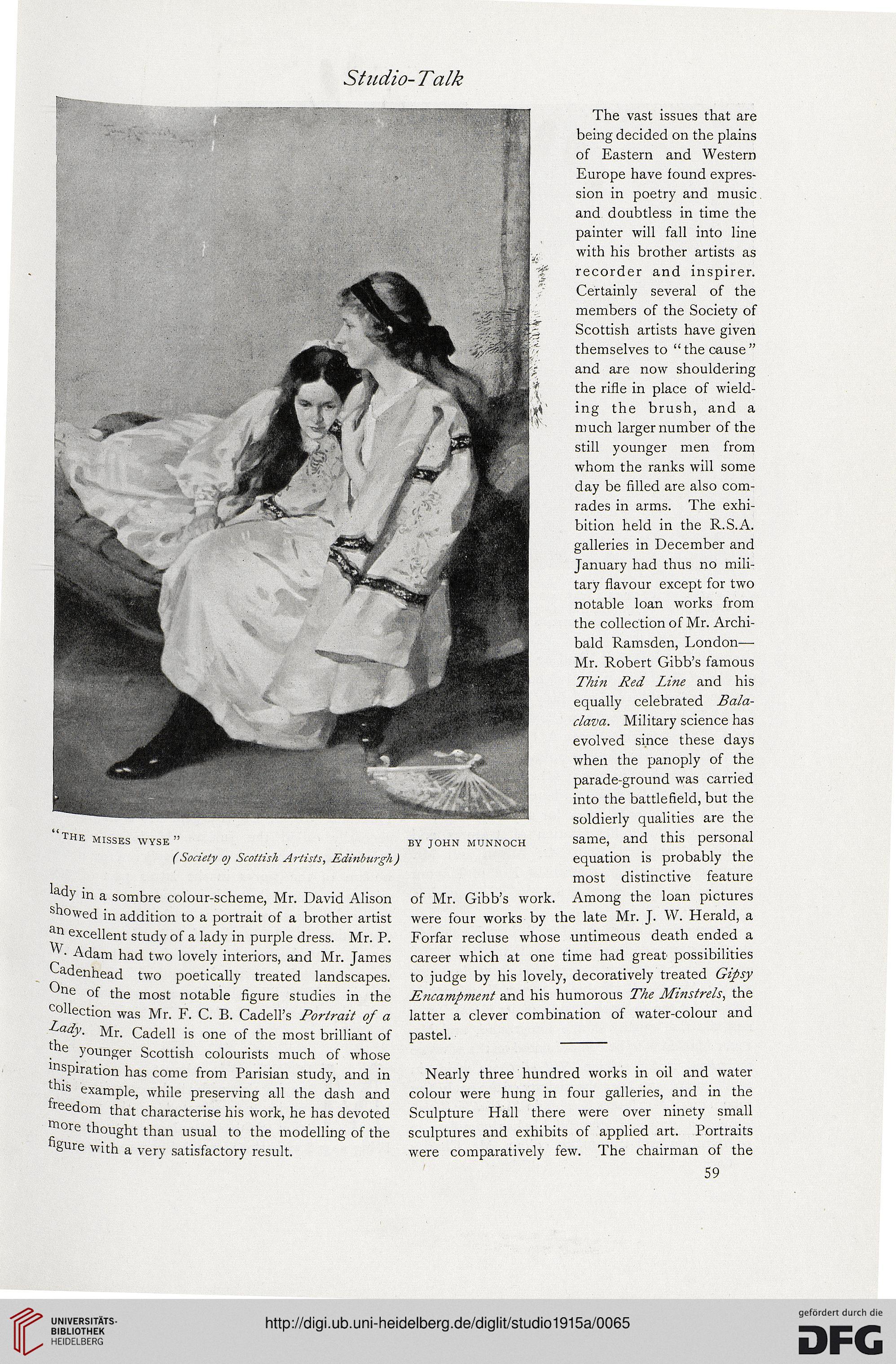Studio-Talk
the misses wyse ”
(Society oj Scottish Artists, Edinburgh)
tady in a sombre colour-scheme, Mr. David Alison
showed in addition to a portrait of a brother artist
an excellent study of a lady in purple dress. Mr. P.
^■ Adam had two lovely interiors, and Mr. James
Cadenhead two poetically treated landscapes.
One of the most notable figure studies in the
collection was Mr. F. C. B. Cadell’s Portrait of a
Lady. Mr. Cadell is one of the most brilliant of
the younger Scottish colourists much of whose
Aspiration has come from Parisian study, and in
this
example, while preserving all the dash and
_rivJ „ 1111V »mg cm. lug uaau a.nu
freedom that characterise his work, he has devoted
m°re thought than usual to the modelling of the
figure with a very satisfactory result.
The vast issues that are
being decided on the plains
of Eastern and Western
Europe have found expres-
sion in poetry and music
and doubtless in time the
painter will fall into line
with his brother artists as
recorder and inspirer.
Certainly several of the
members of the Society of
Scottish artists have given
themselves to “the cause”
and are now shouldering
the rifle in place of wield-
ing the brush, and a
much larger number of the
still younger men from
whom the ranks will some
day be filled are also com-
rades in arms. The exhi-
bition held in the R.S.A.
galleries in December and
January had thus no mili-
tary flavour except for two
notable loan works from
the collection of Mr. Archi-
bald Ramsden, London—
Mr. Robert Gibb’s famous
Thin Red Line and his
equally celebrated Bala-
clava. Military science has
evolved since these days
when the panoply of the
parade-ground was carried
into the battlefield, but the
soldierly qualities are the
same, and this personal
equation is probably the
most distinctive feature
of Mr. Gibb’s work. Among the loan pictures
were four works by the late Mr. J. W. Herald, a
Forfar recluse whose untimeous death ended a
career which at one time had great possibilities
to judge by his lovely, decoratively treated Gipsy
Encampment and his humorous The Minstrels, the
latter a clever combination of water-colour and
pastel. _
Nearly three hundred works in oil and water
colour were hung in four galleries, and in the
Sculpture Hall there were over ninety small
sculptures and exhibits of applied art. Portraits
were comparatively few. The chairman of the
BY JOHN MUNNOCH
59
the misses wyse ”
(Society oj Scottish Artists, Edinburgh)
tady in a sombre colour-scheme, Mr. David Alison
showed in addition to a portrait of a brother artist
an excellent study of a lady in purple dress. Mr. P.
^■ Adam had two lovely interiors, and Mr. James
Cadenhead two poetically treated landscapes.
One of the most notable figure studies in the
collection was Mr. F. C. B. Cadell’s Portrait of a
Lady. Mr. Cadell is one of the most brilliant of
the younger Scottish colourists much of whose
Aspiration has come from Parisian study, and in
this
example, while preserving all the dash and
_rivJ „ 1111V »mg cm. lug uaau a.nu
freedom that characterise his work, he has devoted
m°re thought than usual to the modelling of the
figure with a very satisfactory result.
The vast issues that are
being decided on the plains
of Eastern and Western
Europe have found expres-
sion in poetry and music
and doubtless in time the
painter will fall into line
with his brother artists as
recorder and inspirer.
Certainly several of the
members of the Society of
Scottish artists have given
themselves to “the cause”
and are now shouldering
the rifle in place of wield-
ing the brush, and a
much larger number of the
still younger men from
whom the ranks will some
day be filled are also com-
rades in arms. The exhi-
bition held in the R.S.A.
galleries in December and
January had thus no mili-
tary flavour except for two
notable loan works from
the collection of Mr. Archi-
bald Ramsden, London—
Mr. Robert Gibb’s famous
Thin Red Line and his
equally celebrated Bala-
clava. Military science has
evolved since these days
when the panoply of the
parade-ground was carried
into the battlefield, but the
soldierly qualities are the
same, and this personal
equation is probably the
most distinctive feature
of Mr. Gibb’s work. Among the loan pictures
were four works by the late Mr. J. W. Herald, a
Forfar recluse whose untimeous death ended a
career which at one time had great possibilities
to judge by his lovely, decoratively treated Gipsy
Encampment and his humorous The Minstrels, the
latter a clever combination of water-colour and
pastel. _
Nearly three hundred works in oil and water
colour were hung in four galleries, and in the
Sculpture Hall there were over ninety small
sculptures and exhibits of applied art. Portraits
were comparatively few. The chairman of the
BY JOHN MUNNOCH
59




